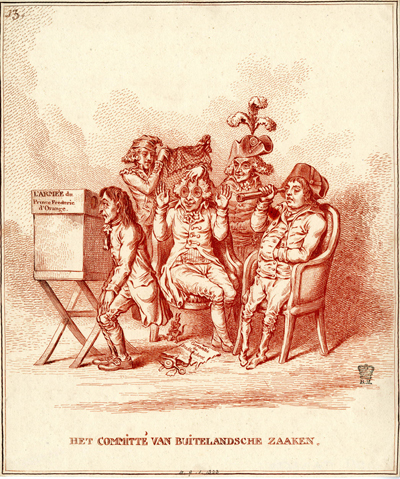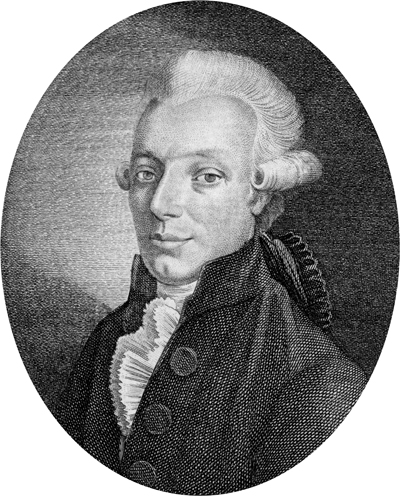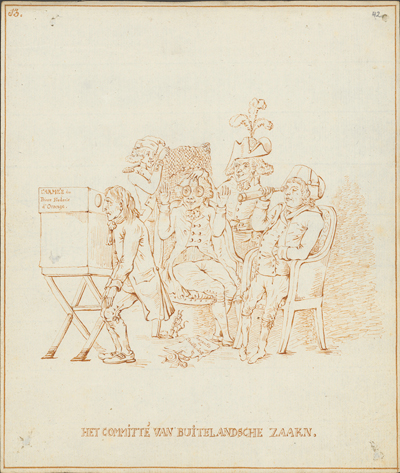Het Committé van Buitelandsche Zaaken
This is the thirteenth plate of a twenty plate series, Hollandia Regenerata, etched by Gillray based on drawings by the Swiss soldier, painter, and caricaturist, David Hess. For more about David Hess, and the political and artistic context of the series satirizing the newly-created and French-supported Batavian Republic, see my Introduction.
The title can be translated as "The Committee for Foreign Affairs" In 1795, foreign affairs in the Batavian Republic were dominated by the French who had invaded Holland in 1792 as part of the War of the First Coalition. But as the Coalition partners, including Prussia, Austria, and Britain suffered defeats at the hands of the French and began to withdraw, the Batavian Patriots within the Low Countries who had long wanted to be rid of the Stadholder Prince of Orange found common cause with the French and in January 1795 succeeded in driving William V out of the country. But the French refused to recognize the Batavians as the legitimate government until a number of substantial demands had been met, including an indemnity of 100 million guilders, a large loan to the penurious French government, and a secret clause in which the Dutch agreed to support an occupying army of 25000 French troops for as long the war lasted.

Het
Committé van Buitelandsche Zaaken
[1796?]
© Trustees of the British Museum
According to Joost Rosendaal whose "Nawoord" to the wonderful 2007 facsimile edition of Hollandia Regenerata is essential reading for anyone interested in the series, several of the figures in the print can be identified. The man with the withered legs is Jacob George Heironymus Hahn, a lawyer from Leiden, an ardent democrat, and one of the leaders of the later stages of the Batavian Revolution. He was a member of the original Provisional Representatives of the People of Holland and was part of the Committee for Foreign Affairs from 27 March 1796 to 22 January 1798. The man trying on the glasses is Nicholas van Staphorst, a banker, and one of several brothers, all committed to the Patriot cause. He had an active correspondence with members of the French Directorate about their support of a Batavian Revolution. Like Hahn he was also a member of the Provisional Representatives. The military man standing between them is the French General Jean-Charles Pichegru, who led the French invasion of Holland, and whose movements had been carefully followed by the Batavians since they could not have afforded to rise up against the Prince of Orange without French support. A third, possibly Pieter Paulus, is gazing at a peep show labeled "The Army of Prince Frederick of Orange." The label is in French, suggesting that it is their creation. And indeed the French had a vested interest in supporting rumors of an counter-invasion by the son of the Stadtholder to justify the standing army of 25,000 men which continued to occupy much of the country, especially at Osnabruck.

© Collectie Rijksmuseum Amsterdam
Under the table next to a little devil who appears to be digging a hole, there is a torn sheet of paper inscribed with Guarantie du Stadhouder. This refers to the Act of Guarantee which had made the position of Stadtholder a hereditary one, and thus the exclusive privilege of the house of Orange-Nassau. One of the first acts of the Provisional Representatives of the new Batavian state, had been, in fact, to rescind (and burn) the Act of Guarantee.
As with all the plates in the series, the corresponding page to the image contains one or more appropriately ironic Biblical quotations in Dutch and English and a satiric "Explanation" in French. The Biblical quotation is a straightforward denunciation of the French "vision" for Holland. And it is largely justified. The French Directory had little interest in the Netherlands and its people except as they could be useful to France.
Jeremiah, xiv. I 4. "They prophecy unto you a false vision, and divination, and a thing of nought, and the deceit of their heart."
The ironic "Explanation." focuses upon these false French friends and the shortsightedness of the Dutch leaders, who believed their revolutionary cant and were blind to the real aims of the French Directorate.
Bien heureux sont ceux qui ont de fideles amis, et qui mé ritent d'en avoir. Ces citoyens ont la vüe un peu basse, à force d'avoir travaillé au salut de la patrie. Ils ne voyent pas trop bien dans le lointain ; mais leurs bons alliés leur pretent des lunettes et des telescopes si bien adaptés a leurs yeux, qu'ils ont l'air de voir les étoiles en plein midi.
And here is my free English translation.
Happy are those who have good friends, and who deserve to have them. These citizens have poor vision, a result of having worked tirelessly for the salvation of their country. They do not see too well at a distance; but their good friends have provided them with glasses and telescopes so well adapted to their eyes, that they seem to see the stars at midday.

Het Committé
van Buitelandsche Zaaken
[1796?]
© Zentralbibliothek Zürich
Like most of the plates of Hollandia Regenerata, Gillray follows the Hess's drawing closely. The basic disposition of the figures and meaning of the print both derive from Hess, but Gillray has sharpened every line and, with a wonderful use of shading, given a depth and solidity to the background, foreground, and figures (especially their clothes) that is missing in the original Hess drawing.
Sources and Reading
- Commentary from the British Museum on Het Committé van Buitelandsche Zaaken.
- "Batavian Republic," Wikipedia
- "Flanders Campaign," Wikipedia
- "Act of Guarantee," Wikipedia
- "David Hess (painter)," Wikipedia
- "David Hess," SIKART Dictionary
- "Mr. JGH (George) Hahn," Wikipedia
- "Jean-Charles Pichegru," Wikipedia
- "Nicolaas van Staphorst," Wikipedia
- David Hess, Hollandia Regenerata (1797), Nawoord by Joost Rosendahl, Uitgeverij Vantilt, 2007
- Simon Schama, Patriots and Liberators: Revolution in the Netherlands 1780 - 1813, London, 1992
Comments & Corrections
NOTE: Comments and/or corrections are always appreciated. To make that easier, I have included a form below that you can use. I promise never to share any of the info provided without your express permission.